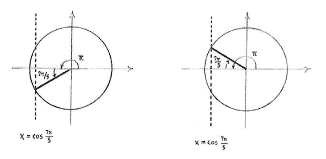Solution 4.3:2b
From Förberedande kurs i matematik 1
(Difference between revisions)
m |
|||
| (3 intermediate revisions not shown.) | |||
| Line 1: | Line 1: | ||
| - | {{ | + | If we write the angle <math>\frac{7\pi }{5}</math> as |
| - | + | ||
| - | < | + | {{Displayed math||<math>\frac{7\pi}{5} = \frac{5\pi+2\pi}{5} = \pi + \frac{2\pi }{5}</math>}} |
| - | {{ | + | |
| + | we see that <math>7\pi/5</math> is an angle in the third quadrant. | ||
| + | |||
| + | [[Image:4_3_2_b.gif||center]] | ||
| + | |||
| + | The angle between <math>0</math> and <math>\pi</math> which has the same ''x''-coordinate as the angle <math>7\pi/5</math>, and hence the same cosine value, is the reflection of the angle <math>7\pi/5</math> in the ''x''-axis, i.e. | ||
| + | |||
| + | {{Displayed math||<math>v = \pi -\frac{2\pi}{5} = \frac{3\pi}{5}\,\textrm{.}</math>}} | ||
Current revision
If we write the angle \displaystyle \frac{7\pi }{5} as
| \displaystyle \frac{7\pi}{5} = \frac{5\pi+2\pi}{5} = \pi + \frac{2\pi }{5} |
we see that \displaystyle 7\pi/5 is an angle in the third quadrant.
The angle between \displaystyle 0 and \displaystyle \pi which has the same x-coordinate as the angle \displaystyle 7\pi/5, and hence the same cosine value, is the reflection of the angle \displaystyle 7\pi/5 in the x-axis, i.e.
| \displaystyle v = \pi -\frac{2\pi}{5} = \frac{3\pi}{5}\,\textrm{.} |

